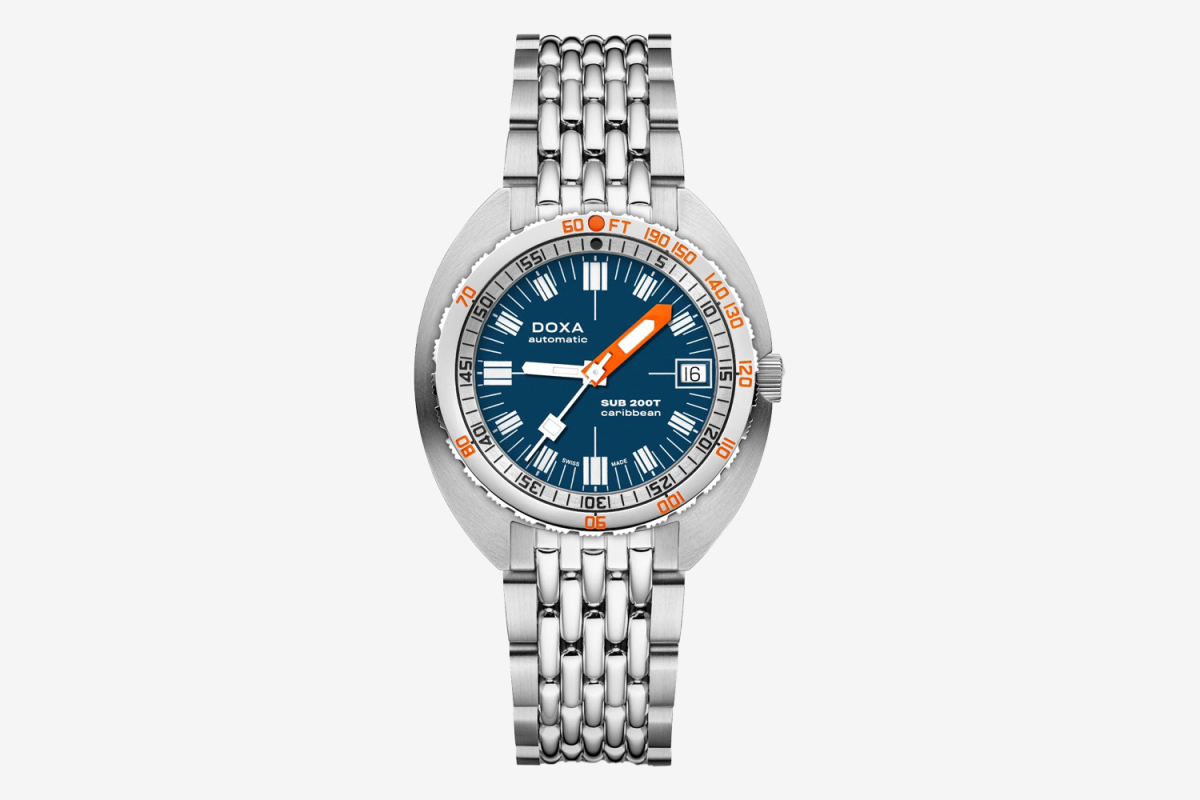I’ll admit that I came to Doxa relatively late in my horological journey. I didn’t grow up reading Clive Cussler novels — I was more of a Hemingway and Fleming guy — and though my parents used to scuba dive in the 1970s and 1980s, I didn’t get certified myself until I was 27. It was during my first stint working at Analog:Shift that I encountered the brand’s vintage wares in person, where my boss and dear friend James Lamdin kept them in stock. Lamdin, a Doxa diehard, and Jason Heaton, a veteran watch writer, diver and another Doxa über-fan, have had an outsized hand in the resurgence of the brand’s popularity amongst modern collectors.
However, considering there are many likely still unfamiliar with Doxa, it’s worth shedding a bit of light on the brand for a moment. Founded in 1889 by Swiss watchmaker Georges Ducommun, the firm originally made pocket and dress watches. It wasn’t until 1967 that, after consulting with none other than Jacques Cousteau, Doxa debuted its Sub 300, a dive watch with a bright orange dial that could easily be seen at depth by scuba divers. It wasn’t just the dial that differentiated this watch from the Rolex Submariner, the Blancpain Fifty Fathoms and other similar fair: Machined from a solid block of stainless steel, the Sub 300 featured a chunky cushion case, an oversized minute hand for easy calculation of elapsed or decompression time, a beads-of-rice bracelet with a spring-loaded dive extension, and a bezel with both elapsed time and the U.S. Navy’s no-decompression time scale. Now here was a purpose-built tool meant for serious divers.
Over the years, Doxa has released numerous iterations of its cushion-cased diver — in chronograph form, in souped-up form with more water resistance, in thinner form with less water resistance. But its bread and butter, the Sub 300, has always been its signature product, and an icon of dive watch design. The only issue with it, as far as some were concerned, was its 42.5mm width — this, combined with the profile of the cushion case, makes it wear rather large on the wrist, which is unwelcome for shorter guys or for the smaller-wristed. (To be fair, I should state that many collectors maintain that this model actually wears much smaller on the wrist than these dimensions would suggest — but to each his own.) And while the brand did deliver a pared-down version in the form of the Sub 200, this watch still measured 42mm. What if Doxa could simply slim down the Sub 300?

The Sub 200T
Well, that’s exactly what it did, which it released in the form of the Sub 200T this year during Watches & Wonders. (Or, rather, roughly in concert with W&W — while the brand doesn’t exhibit at Geneva’s Palexpo, it does set up shop in town at the Beau-Rivage hotel, where journalists and collectors have the opportunity to check out its new wares.) Somewhat confusing naming conventions aside — actually, make that highly confusing naming conventions aside, if we’re gonna call a spade a spade — the Sub 200T is the most exciting Doxa release of the past five years, and perhaps of the past decade.
In shrinking the Sub 300 down to 39mm, all of a sudden, dudes like me — with my vertically challenged 5’8″ frame and 7″ wrist — can happily wear a Doxa and not feel like they have a dinner plate on their wrist. They can relish in the multitude of fancifully named, colorful dials, made even more numerous by the addition of both classic “Iconic” (matte) as well as modern “Sunray” finishes, plus a cool new Sea Emerald colorway. Each of the 13 dial options — there are eight colors, but green, silver and white only feature one iteration each — is further available on either the beloved Doxa beads-of-rice bracelet with dive extension, or a dial-matching, colored rubber strap. Best of all? This watch is just $1,550 on rubber or $1,590 on steel — which, while not “impulse buy” territory, is distantly affordable for a Swiss-made automatic diver in a classic design made by a medium-sized brand.
I had the opportunity to wear the new Sub 200T and I must tell you: I am positively freaking delighted with it. (Unfortunately, I didn’t have any diving opportunities coinciding with my time with the watch, so I didn’t get to dive with it. Alas, this shall be a terrestrial review.) I requested the darker blue Caribbean color in the Iconic finish to putz around with for the week, and I am here to tell you, dear reader — as well as my therapist, my mother and anyone else who will care to listen: I think I’m qualified to look for buried Civil War-era ironclads hidden in the Sahara! In short: I think I’m a Doxa guy now.
The Best Father’s Day Gifts to Bestow on Every Dad in Your Life
Or buy for yourself. We won’t tell.
The Case
There’s something about the Doxa cushion case that feels much more utilitarian than good-looking — that enormous flank of steel surrounds the crown without the need for separate crown protectors, and positively envelops the bracelet connection points at the lugs — but I would still contend that this is a good-looking watch. Heck, I don’t even like the color orange, but it pops perfectly in the no-decompression scale above the more standard count-up scale on the Sub 200T’s bezel, and in the gigantic minute hand that can’t possibly be confused with the hour hand.
Hours, in most scuba diving, don’t particularly matter — minutes will get you killed. And the no-deco bezel? It gives you the maximum time you can spend at a given depth without having to make a decompression stop on the way back up — though modern safety guidelines generally account for a three-minute safety stop to dissolve any excess nitrogen that’s built up in the bloodstream.

The Dial
The Caribbean dial itself, with its large white minute track, signature boxy indices, aforementioned handset with orange minute hand, and framed date window, is a perfect picture of late-’60s/anticipatory early-1970s watch design — and it just works, looking as cool now as it did back in 1967. (To be fair, I wasn’t around in ’67, so I’m really only assuming it looked cool then. But I’ve seen pictures!) Lots of more expensive watches will omit any sort of colored frame around a date window which, in my humble opinion, cheapens the looks of the dial. Here, the look is considered and polished, despite the Sub 200T’s distinctly down-to-esarth price.

The Bracelet
The large case flank, with its brushed top and polished sides, protects a screw-down crown with an orange Doxa fish logo, while the screw-down caseback likewise features a nicely embossed logo. My only real gripe on this watch — which hugs the wrist, wears comfortably and looks great — is with the beads-of-rice bracelet. The construction of the links and the corresponding comfort level are just fine, but two things persistently irk me. I know this is a feature of all Doxa beads-of-rice bracelets, but to my eye, the way it attaches to the watch looks odd: There’s a smaller end link with straight edges, immediately after which is a wider link with curved edges, after which begins a slight taper.
Personally, I think this might look okay if the bracelet then featured a more significant taper down to its buckle — but it doesn’t. By the time you reach the third or so link down on the bracelet, that’s all she wrote, and you’re left with a chunky length of steel that terminates in an extending dive buckle. (This system, which uses two push-buttons to ratchet open along a multi-stop track, does offer convenient expansion, but requires two hands to operate well, and sometimes comes undone on its own when donning and doffing the watch.) Some will no doubt laugh at this particular nitpick, but to my mind, the lack of significant taper in a bracelet makes an otherwise handsome watch look distinctly cheaper. (Ever seen a ~32mm Patek Philippe Calatrava ref. 96 on a leather strap with no taper? It transforms instantly from one of the most beautiful designs ever conceived into something that instantly loses 85% of its elegance!) The taper is life.

Should You Buy One?
Without going (further) into a dissertation on the economic implications of stamping five different link sizes as opposed to three and its corresponding effects on margin — I don’t know anything about that stuff, and just like using big words — I would posit that a properly tapering bracelet, with a more modern diver’s extension, would make the Sub 200T feel like a million bucks. Alas, however, I don’t think this would necessarily stop me, or someone like me, from buying one, especially considering that you can easily order the watch with one of Doxa’s excellent rubber straps, or throw it on a NATO.
Measuring 10.7mm tall, featuring a flat sapphire crystal, fully lit with Super-LumiNova and boasting 200m of water resistance, the Sub 200T is still a professional-grade tool watch despite its slimmed-down proportions. Powered by the workhorse Sellita SW200-1 automatic movement with 38 hours of power reserve, it doesn’t reach Rolex, Omega or Blancpain levels of luxurious refinement, but then again, that’s not really its design remit. This is a watch designed expressly for the water — for getting wet, dirty and banged up. It doesn’t have to look good in the boardroom, nor does it need to feel like a luxury product.
Thankfully, it feels good and does look great — and at this price, there’s little one can find fault with.
This article was featured in the InsideHook newsletter. Sign up now.
























